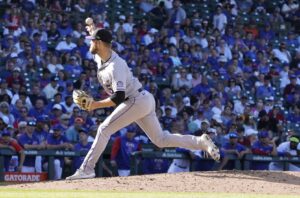Reliving the Atlanta Braves Magical 1995 Season
Happy Memorial Day Weekend! Next up on the docket in our “Reliving History” Series is a focus on the 1995 Atlanta Braves. During that time, the Braves were in the midst of winning fourteen consecutive division titles (1991-2005). Despite that, 1995 was the only year in that run that the team came out on top as World Series Champions.
During what was their 30th year in Atlanta, the Braves finished the regular season with a 90-54 record under the guidance of Hall of Fame manager Bobby Cox. What’s even more interesting is the fact that it came during a shortened season due to the MLB strike.
For the Braves, the brightest quality of their team that year was their pitching staff. Most notably, their starting rotation. As a unit, Atlanta’s pitching staff posted a 3.44 ERA or a 123 ERA+ over the course of the regular season. That translated into a Run Differential value of +105.
From a lineup perspective, the Braves finished the regular season in the middle-to-lower portion of baseball in many categories. As a team, the Braves hit .250/.326/.409. Collectively, that translated to a .735 OPS, which was good enough for 18th place in MLB.
The Professor Teaches a Lesson
Anchoring the top of the starting rotation for Atlanta that season was right-hander Greg Maddux. The future Hall of Famer signed with the Braves as a free agent in December of 1992. The 1995 regular season was easily one of the greatest seasons for the then 29-year-old. Maddux concluded the regular season with a 1.63 ERA over 209 2/3 innings of work. In that span, he had a career-best Fielding Independent Percentage (FIP) of 2.26 and a WHIP of 0.811.
Maddux later went on to win his fourth consecutive Cy Young Award that season. In addition, he was named an All-Star, won a Gold Glove Award, and finished third in National League Most Valuable Player Award voting. Still to this day, it’s hard for any starting pitcher to compare to what Maddux did in 1995.
When it came to pitching at home inside Atlanta-Fulton County Stadium compared to on the road, Maddux was dominate in both settings, but really shined on the road. Away from Atlanta-Fulton County Stadium, he held opposing batters to a slash line of .178/.205/.231 over 15 games or 414 plate appearances. That stat line alone just reeks of dominance!
Although Maddux was great during the regular season, he took it to another level in the postseason. During the National League Championship Series against the Cincinnati Reds, he made one start pitching eight innings and posting a 1.13 ERA. Once the World Series against the Cleveland Indians rolled around, he made two starts, including one complete game. Over those three starts, he posted a 2.25 ERA with a 0.750 WHIP. Maddux was otherworldly during both the regular and postseason in 1995.
Glavinator Anchors Down the Two Hole
Next up in the Braves’ starting rotation was left-hander Tom Glavine. Glavine was also 29-years old during the 1995 season and concluded the regular season with a 3.08 ERA over 198 2/3 innings of work. He went on to finish third in National League Cy Young Award voting and didn’t only excel on the pitching mound, but at the plate as well.
In fact, Glavine ended up winning a Silver Slugger Award that season. At the plate, he recorded 74 plate appearances and wound up batting .222/.258/.286 with 14 hits, one double, one home run, eight RBI, two walks, and 15 strikeouts. Combine that all together and it equaled a Runs Above Average (RAA) value of seven. Pretty good for a starting pitcher! As an extra side note, Glavine would go on to win four Silver Slugger Awards during his big league career.
The brightest point of the season came for Glavine during the month of August. That’s when the left-hander posted a 1.45 ERA over 37 1/3 innings of work. In that span, he held opposing batters to a .212/.273/.280 slash line.
Easily the shining point of that year for the eventual Hall of Famer came during the World Series. Glavine pitched to the tune of a 1.29 ERA over two starts in the series. He contributed enough to win Most Valuable Player honors coming out of that World Series. Couple that with the dominance of Greg Maddux during the Fall Classic, and it’s easy to see why the Braves came out on top.
Smoltzie Rounds Out the Three-Headed Monster
Rounding out the three-headed monster was right-hander John Smoltz. The future Hall of Famer was originally acquired by the Braves in a trade with the Detroit Tigers in August of 1987. Going the other way to Detroit in that trade was right-hander Doyle Alexander. During the 1995 season, Smoltz was right in the midst of his peak at 28 years old.
Over the span of the regular season, the righty posted a 3.18 ERA over 29 starts or 192 2/3 innings pitched. In that span, Smoltz recorded a 3.30 FIP, 193 strikeouts, and a 133 ERA+. In many ways, he used that season as a stepping stone to his 1996 season in which he would go on to win the National League Cy Young Award.
One intriguing aspect about Smoltz from that year was his struggles in the postseason. He finished the National League Division Series against the Colorado Rockies with a 7.94 ERA over 5 2/3 innings of work. He only made one start that series and had a Hits-Per-9 Rate of 7.9 in that game. Things didn’t get any better in the World Series.
During the World Series against the aforementioned Cleveland Indians, Smoltz only made one start. The right-hander only went 2 1/3 innings and posted a 15.43 ERA over that small sample. During that game, Smoltz gave up six hits, recorded four earned runs, and had a WHIP of 3.429. This performance in the postseason was unorthodox for Smoltz, but he returned to form in the 1996 postseason.
Complementary Pieces on the Pitching Staff
As any casual or diehard baseball fan knows, to come out as World Series Champions pitching and defense matters the most. It was hard to beat the three-headed monster in the Braves starting rotation. But Atlanta did have a few nice complimentary pieces in their bullpen that helped contribute to their winning ways.
One of those individuals was right-handed closer Mark Wohlers. Wohlers had a career season in 1995, posting a 2.09 ERA over 64 and 2/3 innings of work. Altogether, he finished 49 games for Atlanta and locked down 25 saves in the process. Additionally, the righty had a career-best 1.88 FIP and 12.5 K/9 rate that year. Where Wohlers really excelled was in high leverage situations where he held opposing batters to a .198/.279/.207 slash line. Between the NLCS and World Series, Wohlers posted a 1.80 ERA with 11 strikeouts over ten innings of work.
Another critical part of the Braves bullpen was right-hander Greg McMichael. McMichael also had a career season that year, finishing the regular season with a 2.79 ERA over 80 and 2/3 innings. He faced 337 batters, finished off 16 games, and recorded two saves in the process for Atlanta. Between the NLCS and World Series, McMichael posted a 1.50 ERA with four strikeouts over six appearances.
Young Rookie Starts Building Hall of Fame Resume
Switching over to the offense now, third baseman Chipper Jones was the first of two impact bats for Atlanta. Jones, who would go onto become a future Hall of Famer, was in his first full big league season that year.
Throughout 140 games or 602 plate appearances, Jones recorded a .265/.353/.450 slash line. Over that sample, he recorded 139 hits, 23 home runs, 86 RBI, 73 walks, and 99 strikeouts. If you combine all of that, it equaled a 108 OPS+ and an RAA value of 10. Jones would finish second in National League Rookie of the Year voting and eighteenth in National League Most Valuable Player Award voting.
Looking over the entire regular season, July was the brightest month for the 23-year old. During July, Jones made 106 plate appearances and hit .300/.406/.389. Additionally, against the Philadelphia Phillies, he hit .293/.442/.561 over 12 different matchups. In that span, he recorded 12 hits, three doubles, one triple, two home runs, eight RBI, 11 walks, and 11 strikeouts.
During the postseason, Jones hit two home runs during Game One of the National League Division Series. Both of those home runs made him a feared hitter for the Braves heading into the remainder of the playoffs. Additionally, the switch-hitting third baseman made his presence felt during the NLCS against the Reds. During that four-game series, Jones posted a .438/.526/.625 batting line.
Fred “The Crime Dog” McGriff
First baseman Fred McGriff was another impact bat for Atlanta in 1995. During his age-31 season, the first baseman played in every single game (144) and earned his third career All-Star nod. Over those 144 games, McGriff hit .280/.361/.489 with 148 hits, 27 home runs, 93 RBI, 65 walks, and 99 strikeouts. Those numbers allowed McGriff to finish in the Top 20 in National League Most Valuable Player Award voting.
A bulk of the offensive impact for McGriff came against right-handed pitchers. During the regular season, he recorded 393 plate appearances against righties hitting 21 home runs, recording 65 RBI, and locking down a .909 OPS. Another area where he excelled was during situations with Runners In Scoring Position (RISP). That year, McGriff had 168 plate appearances that fell into that category and hit .291/.399/.552.
Once October rolled around, McGriff didn’t stop contributing to the Braves offense in a significant way. One of the most notable moments for McGriff from that postseason occurred during Game Four of the NLDS when the third baseman drove in five runners. Additionally, another key moment for McGriff was during Game One of the World Series. McGriff hit a home run to deep right-center field off of Orel Hershiser to tie the game, which Atlanta would go on to win with a final score of 3-2.
Marquis Grissom – Speedster/Table Setter
As is the case with many traditional baseball teams that experienced success, there was always a batter at the top that set the table for the rest of the lineup. For the Atlanta Braves, that individual was centerfielder Marquis Grissom.
The 28-year old concluded the regular season batting .258/.317/.376 over 606 plate appearances or 139 games. Over that period, Grissom recorded 29 stolen bases and was caught stealing on nine different occasions. Grissom had just enough speed on the base paths to come through in those critical situations for Atlanta.
Additionally, Grissom was very impactful during the World Series. The right-handed-hitting outfielder made 27 plate appearances during the Fall Classic in which he hit .360/.407/.400. Grissom had three stolen bases alone during the series.
Furthermore, if Grissom’s value wasn’t felt at the top of the lineup, it sure was defensively. Grissom went on to win his third consecutive Gold Glove Award and finished the regular season with a cumulative Fielding Percentage of .994. Additionally, he had a Run Factor Per 9 Innings of 2.48, which matched the league average in that category.
Final Thoughts
In the end, the 1995 Atlanta Braves made a huge statement during the thirtieth year in Atlanta. It was a significant stepping stone for a franchise that was right in the middle of a long period of division titles. Led by a three-headed starting pitching monster that no one else in baseball possessed, the Braves finally found a way to come out on top as World Series Champions.
The Braves would go onto finish the decade with two more World Series appearances. Besides the 1996 World Series against the New York Yankees, which Atlanta would go on to lose in six games, the Braves also appeared in the 1999 World Series as well. Unfortunately for Atlanta, this was also against the Yankees. The Braves were swept by New York, and it would be the last time the organization appeared in the Fall Classic since the calendar changed to the new millennium.
Main Photo:
Embed from Getty Images






